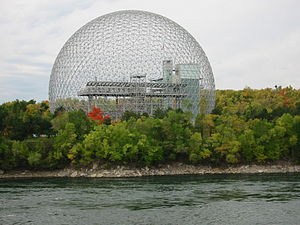User:Arssenev
High-tech architecture and Diagrid shells

Strolling around London, tourists admire the avant-garde skyscraper-“cucumber” 30 St Mary Axe ("The Gherkin") and the overhead cover of the BritishMuseum (BritishMuseum - "Queen Elizabeth II Great Court"). But only few of them know that this delight is aroused by the creative synergy of the two outstanding architects: the Great Russian engineer and architect Vladimir Grigorievich Shukhov and the master of the high-tech architecture Lord Norman Foster. The famous British architect constantly uses the bearing lattice structures (diagrid shells) invented by Shukhov in his masterpieces.
The world’s first bearing diagrid shells of the overhead covers and towers were built by Vladimir Shukhov in 1896 for the biggest pre-revolution exhibition of Russia - XVI All-Russia industrial and art exhibition in Nizhniy Novgorod. The attention of foreign guests was most of all drawn by the open-work lattice steel hyperboloid water tower.
This world’s first hyperboloid diagrid structure-shell still exists near the palace of aristocrats Nechaev in Polibino, not far from the Kulikov field. The Great Maecenas and collector of masterpieces Yuriy Stepanovich Nechaev-Maltsov, who presented Russia with the Museum of Fine Arts (at present GMII after A.S. Pushkin in Moscow), was delighted with the graceful open-work structure of Vladimir Shukhov. He bought the tower at the Nizhniy Novgorod exhibition, and under the personal control of Vladimir Shukhov his first lattice shell was installed near the palace of Nechaev-Maltsov in his country estate Polibino (Dankovskiy area of the Lipetsk region).
The British magazine “The Engineer” wrote an enthusiastic article about this avant-garde lattice structure («The Nijni-Novgorod exhibition: Water tower, room under construction, springing of 91 feet span», «The Engineer», № 19.3.1897, P.292-294, London, 1897.). Shukhov’s lattice shells were also described by the German and French magazines. For the invented steel structures in the kind of bearing lattice shells V.G. Shukhov received patents (No. 1894, No. 1895, No. 1896 dated March 12, 1899):




- No. 1894 - the invention of diagrid covers for buildings made of the straight bearing elements multiply repeating and intersecting in the kind of quadrangles, which work on tension or pressing, with the hanging and prominent form of the cover;
- No. 1895 – the invention of diagrid arch-like covers for buildings made of metal strips put on the edge and bent in the form of a broken line, joined with each other in the bends in such a way that, as a result, it creates a cover consisting of the multiply repeating cells-honeycombs (resembling the bee honeycombs).
- No. 1896 – the invention of diagrid towers in the form of hyperboloid of rotation with rectilinear forming lines, which connect ring bases, with the reinforcement by intermediate rings. As a result, the rectilinear forming lines of the hyperboloid form the bearing lattice shell with cells made of straight elements, which work on pressing.
At the end of XIX century and during the first third of XX century on the territory of Russian Empire and USSR according to V.G. Shukhov’s projects were built more than 250 diagrid structures. During the XX century diagrid structures of bearing shells were used not enough due to the complexity of their calculation without computers. During the second half of XX century the high-tech architects, the famous Buckminster Fuller, Frei Otto and Norman Foster, implemented diagrid shells into the modern practice of construction, and in XXI century shells became one of the main means of form-generating the avant-garde buildings.
Now diagrid shells have become a creative mean of the high-tech architecture, which pretend to domination in the XXI century. The basis of high-tech is the use of the state-of-the-art technologies. At the end of XX century – the beginning of XXI century the perfection of technologies led to the appearance of extremely earnest and very elegant architecture, the recognized leader of which soon became Lord Norman Foster. “Shukhov is one of my heroes!” – Norman Foster says in his interviews. The famous architects Richard Rogers, Paul Andreu, Santiago Kalatrava, Renzo Piano, Nicholas Grimshaw, Zaha Hadid, Massimiliano Fuksas and others use diagrid shells in their creative work. Now lattice shells allow the creation of buildings with a very complex form, including the famous Olympic stadium “Bird’s nest” in Beijing and the amorphous complex “VELA” in Milan.
References
[edit]

(in English)
- Shukhov Tower in Moscow - video
- Vladimir Grigoryevich Shukhov at Structurae – architectural works
- Elizabeth C. English: “Arkhitektura i mnimosti”: The origins of Soviet avant-garde rationalist architecture in the Russian mystical-philosophical and mathematical intellectual tradition”, a dissertation in architecture, 264 p., University of Pennsylvania, 2000.
- "The Nijni-Novgorod exhibition: Water tower, room under construction, springing of 91 feet span", "The Engineer", № 19.3.1897, P.292-294, London, 1897.
(in German)
- Die sparsame Konstruktion
- Rainer Graefe, Jos Tomlow: “Vladimir G. Suchov 1853-1939. Die Kunst der sparsamen Konstruktion.”, 192 S., Deutsche Verlags-Anstalt, Stuttgart, 1990, ISBN 3-421-02984-9.
- Suchov und Gaudi
(in Italian)
- Fausto Giovannardi: "Vladimir G. Shukhov e la leggerezza dell’acciaio", Borgo San Lorenzo, 2007.
(in French)
- Picon, Antoine (dir.): "L'art de l'ingenieur : constructeur, entrepreneur, inventeur", Éditions du Centre Georges Pompidou, Paris, 1997, ISBN 2-85850-911-5
(in Russian)
- Шухов В. Г.: Избранные труды, том 1, «Строительная механика», 192 стр., под ред. А. Ю. Ишлинского, Академия наук СССР, Москва, 1977.
- Грефе Р. и др.: «В. Г. Шухов (1853—1939). Искусство конструкции.», «Мир», Москва, 1994, ISBN 5-03-002917-6.
- Петропавловская И.А.: "Владимир Григорьевич Шухов, 1853-1939", Москва, "Наука", 2004, ISBN 5-02-033173-2.
